Gone are the days when buying herbal supplements was solely based on a recommendation from a friend or family member. With so many options available, it’s easy to get overwhelmed and confused. The labels on herbal supplements can provide valuable information about the product, but understanding them can be a daunting task. That’s why we’ve created this guide to help you make informed decisions. We’ll break down the key elements of herbal supplement labels, explain their significance, and provide tips on how to read and interpret them.
Understanding herbal supplement labels is important as it can help you make informed decisions and avoid potential risks. We’ll show you how to find important information on the label, such as dosage instructions, the list of ingredients, and any safety warnings or precautions. We’ll also guide you on how to evaluate claims and benefits, recognize quality symbols, research manufacturers and brands, and be aware of interactions and side effects.
Key Takeaways:
- Herbal supplement labels provide valuable information about the product.
- Understanding herbal supplement labels can help you make informed decisions and avoid potential risks.
- Important information on the label includes dosage instructions, the list of ingredients, safety warnings or precautions, and quality symbols.
- Evaluating claims and benefits, researching manufacturers and brands, and being aware of interactions and side effects are also essential.
Why is Reading Herbal Supplement Labels Important?
At our organization, we understand that many consumers turn to herbal supplements as a natural alternative to traditional medicine. However, it is essential to recognize the potential risks associated with using these products and take steps to ensure their safety and efficacy. One of the most crucial steps in this process is reading and understanding herbal supplement labels.
Herbal supplement labels are required to adhere to specific regulatory requirements, which include providing important information for consumers. This information can vary from product to product, but in general, it includes:
| Information on herbal supplement labels | What it means for consumers |
|---|---|
| Product name and manufacturer information | Identify the product and its source for potential research and contact information in case of adverse reactions. |
| Net quantity of contents | Determine how much product is in each bottle or package. |
| Ingredient list and amount per serving | Identify the individual components of the supplement and the amount of each one. |
| Instructions for use, dosage, and frequency of consumption | Understand how much to take, how often to take it, and how to consume it appropriately. |
| Warnings about potential risks or side effects | Understand potential risks or side effects to make an informed decision about whether to use the supplement or not. |
| Certifications and/or quality symbols | Recognize reputable organizations and certifications that meet specific standards and criteria. |
Ignoring the information on herbal supplement labels can lead to potential harm, as it is essential to know what you are putting into your body. Reading the label can help you make informed decisions about the product’s safety and efficacy and avoid adverse reactions.
In the next sections, we will explore the key elements of herbal supplement labels and provide guidance on how to understand and apply this information to make informed decisions about herbal supplement use.
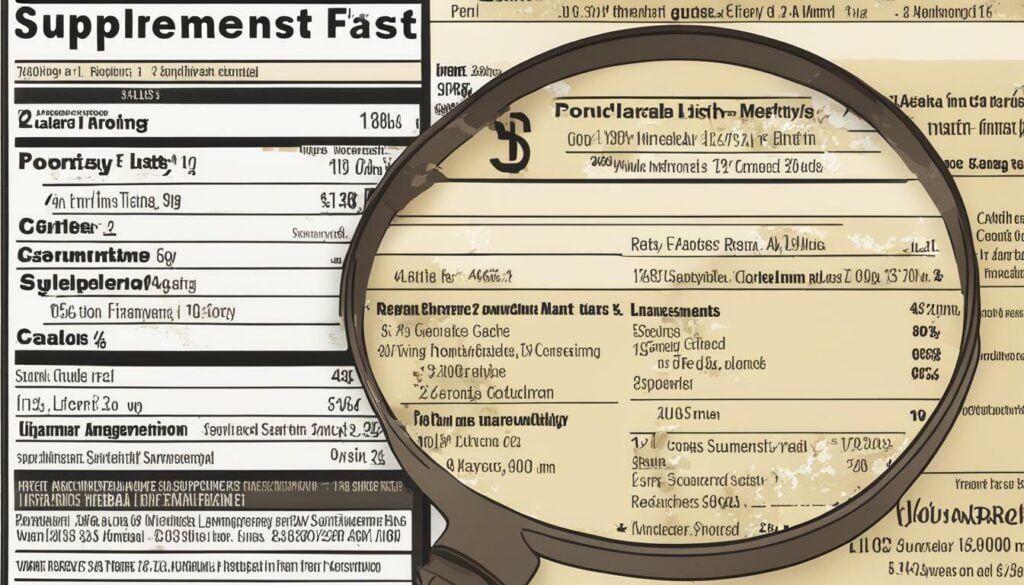
Key Elements of Herbal Supplement Labels
Understanding the key elements of herbal supplement labels is crucial to make informed decisions. Decoding herbal supplement labels can seem daunting, but they provide essential information about the product. Here are the main elements to look for:
| Element | Description |
|---|---|
| Product Name | The name of the supplement should be clear and easy to read. It should be the same on the front label and the Supplement Facts panel. |
| Dosage Instructions | The dosage instructions indicate how much of the supplement to take and how often. It also provides any specific instructions regarding timing or administration. |
| List of Ingredients | The list of ingredients provides a detailed breakdown of the supplement’s contents, including the quantity of each ingredient. |
| Safety Warnings or Precautions | The safety warnings or precautions list any potential side effects or interactions with medications or existing health conditions. It may also indicate which populations or conditions require caution when using the supplement. |
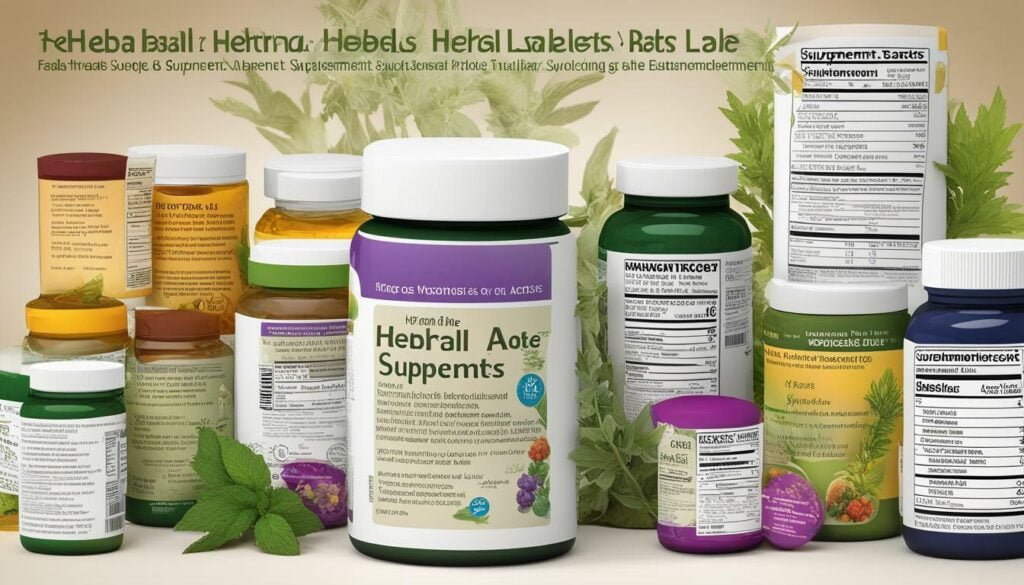
It is important to note that some herbal supplements may contain multiple active ingredients. In this case, it is crucial to read the label carefully to determine the quantity of each ingredient in the supplement.
In the next section, we’ll take a closer look at how to understand the ingredients list in herbal supplement labels.
Understanding the Ingredients List
One of the essential elements of herbal supplement labels is the list of ingredients. As we mentioned earlier in this guide to understanding herbal supplement labels, ingredients can provide valuable information about the composition of the product and help consumers make informed decisions.
However, deciphering the ingredients list can be challenging, especially for those who are unfamiliar with common herbal ingredients. Here are some tips to help you understand the ingredients list:
- Recognize common ingredient names: Many herbal supplements use scientific names for ingredients, which can be confusing. However, you can usually find a common name in parentheses next to the scientific name. For example, Echinacea purpurea (purple coneflower) or Curcuma longa (turmeric).
- Identify potential allergens: The label should also indicate if the product contains any known allergens or irritants. These may include common allergens such as peanuts, soy, or gluten.
- Recognize herbal extracts: Herbal extracts are commonly used in supplements and are usually listed on the label as percentages or ratios. For example, if a label states that a supplement contains 50mg of “4:1 valerian root extract,” it means that 200mg of valerian root was used to make 50mg of extract.
- Research individual ingredients: If you are unsure about an ingredient or want to learn more about its potential effects, research it online or speak to a healthcare professional.
By understanding the ingredients list, you can gain valuable insight into the composition of the product and its potential effects. Keep in mind that some ingredients may interact with medications or have side effects, so it’s vital to do your research before taking any new supplement.
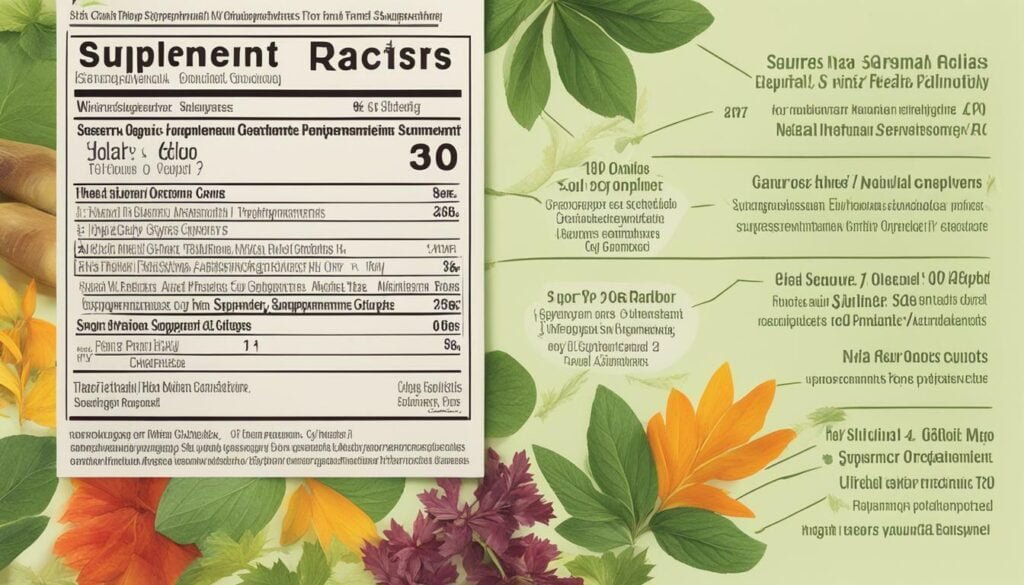
Unraveling the Dosage Instructions
Herbal supplement labels provide important information about the recommended dosage, frequency of consumption, and specific instructions regarding administration. Understanding this information is critical to ensure optimal results and safety, as well as to avoid potential overdose or underdose.
When reading herbal supplement labels, look for the recommended serving size, which is typically provided in measurements such as milligrams (mg) or capsules. It is essential to follow these instructions carefully, as exceeding the recommended dosage can be harmful.
If the label states that the supplement should be taken with food or water, be sure to follow these instructions as well. Some supplements may also require specific timing instructions, such as before or after meals or at certain times of day.
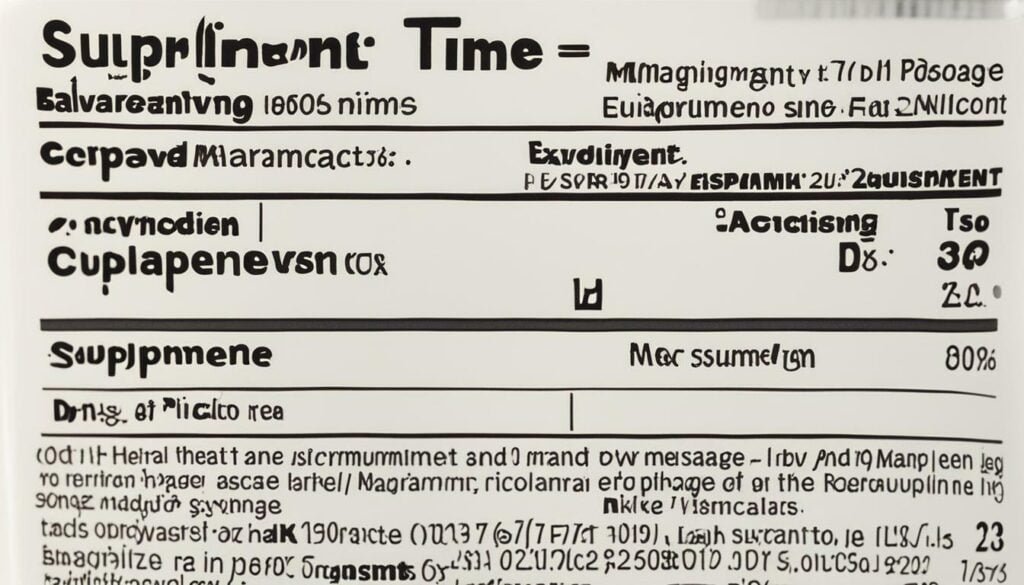
It is essential to note that dosage instructions may vary based on factors such as age, weight, and health condition. Always consult with a healthcare professional before starting any new supplement regimen, particularly if you are currently taking medications or have an existing health condition.
Herbal supplement labels may also include information regarding the maximum recommended dosage or advisories for specific populations, such as pregnant or breastfeeding women. It is crucial to pay attention to these warnings and follow them accordingly.
In summary, understanding dosage instructions is crucial when reading and interpreting herbal supplement labels. By following these instructions carefully and consulting with a healthcare professional if necessary, you can ensure optimal safety and effectiveness when taking herbal supplements.
Identifying Safety Warnings and Precautions
When it comes to herbal supplement labels, it’s important to pay attention to any safety warnings or precautions. These can include information about potential interactions with medications or existing health conditions, as well as advisories for specific populations such as pregnant or nursing women.
Tip: Look for any bolded or highlighted text on the label that may indicate a safety warning or precaution.
It’s crucial to understand and follow these warnings to ensure your safety and avoid any negative effects. If you have any doubts or questions regarding a supplement’s safety, consult your healthcare professional before consuming it.
In addition to the safety warnings, the label may also provide information on potential side effects. This can include physical symptoms as well as allergic reactions. It’s important to review this information carefully and be aware of any potential risks.
Tip: If you experience any negative side effects after consuming an herbal supplement, consult your healthcare professional immediately.
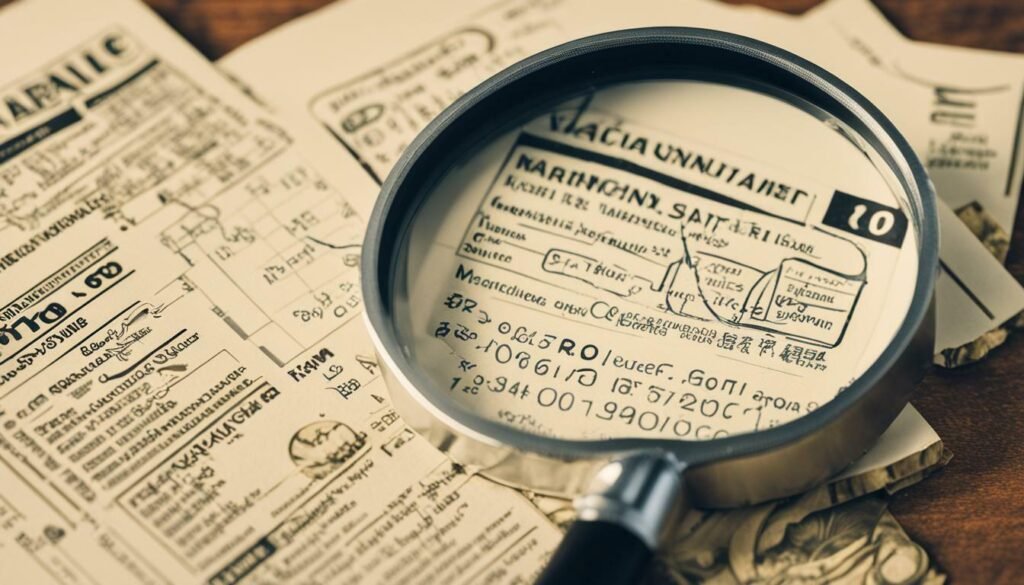
Remember, taking herbal supplements carries some level of risk, just like any medication or supplement. Knowing how to read and understand herbal supplement labels can help you make informed decisions and minimize these risks.
Evaluating Claims and Benefits
Decoding herbal supplement labels involves critically evaluating the claims and benefits presented. It’s essential to look beyond the catchy promotional phrases and examine the evidence behind the claims.
Understanding herbal supplement labels means recognizing the difference between fact and fiction. Don’t be swayed by bold claims that promise to cure all ailments. Instead, focus on claims that are supported by reliable scientific research. Keep in mind that the FDA do not regulate herbal supplements, so the claims on the label may be misleading or exaggerated.
Look for specific claims rather than vague statements that don’t offer clear benefits. For example, a product claiming to support overall health and wellness is too broad to be meaningful. On the other hand, a claim that the product reduces inflammation, boosts immunity, or promotes cognitive function may be more specific and easier to evaluate.
When evaluating benefits, consider the quality and quantity of the evidence supporting them. Look for information on clinical studies conducted on the product’s ingredients and their effects on the body. Check the dosage used in the studies to determine whether it is comparable to the dose in the supplement.
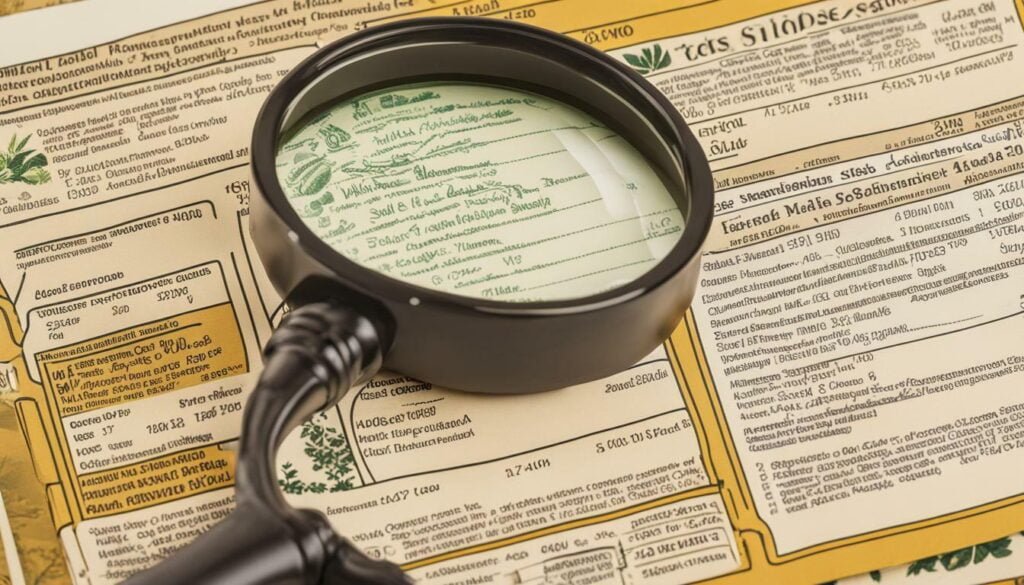
Be cautious of testimonials or endorsements as they may be biased or fabricated. Consider the reputation of the person or organization making the endorsement. If in doubt, do additional research on the claims and the credibility of the sources.
To avoid falling for grandiose claims or misleading advertising, it’s crucial to develop a discerning eye when reading herbal supplement labels. By carefully evaluating claims and benefits, consumers can make informed decisions that support their health and wellbeing.
Recognizing Certification and Quality Symbols
As we’ve discussed, reading herbal supplement labels is a critical step in making informed choices about these products. Another important aspect to consider when evaluating herbal supplements is the presence of certification and quality symbols on the label.
These symbols can give consumers peace of mind that the supplement they are purchasing has been tested and meets certain standards for quality and safety. It’s important to note that not all symbols are created equal, and some may carry more weight than others.
| Symbol | Description |
|---|---|
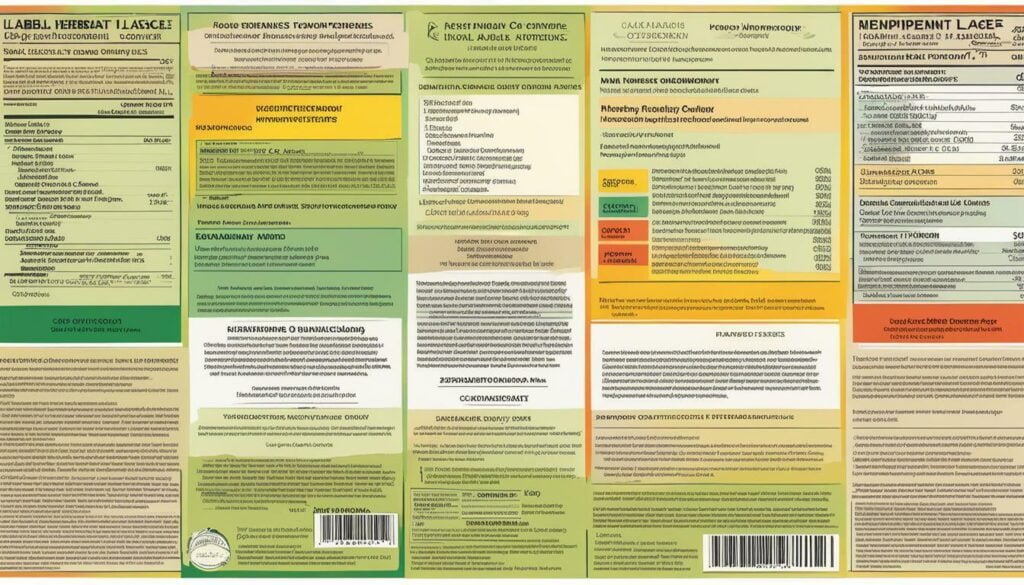 USP Verified Mark USP Verified Mark |
This symbol is issued by the United States Pharmacopeia (USP) and indicates that the supplement has been tested for purity, potency, and quality. This is one of the most respected symbols in the industry. |
| Various Organic Symbols | The US Department of Agriculture (USDA) and other organizations issue symbols indicating that a product meets organic standards. These symbols may indicate that the product was grown without synthetic pesticides or fertilizers, for example. |
| Non-GMO Project Verified | This symbol indicates that the supplement does not contain genetically modified organisms (GMOs). The Non-GMO Project is a non-profit organization that verifies products as non-GMO. |
| Other Third-Party Symbols | There are various other symbols that may appear on supplement labels, indicating that the product has been tested for specific characteristics or meets specific standards. It’s important to research these symbols to ensure they are issued by reputable organizations. |
It’s worth noting that while these symbols can be helpful in guiding supplement purchases, they aren’t the only factor to consider. Consumers should also research the manufacturer and brand, as well as the specific ingredients and potential interactions or side effects. By using a holistic approach when evaluating herbal supplements, consumers can make informed decisions that support their health and wellness goals.
Researching Manufacturers and Brands
When considering purchasing an herbal supplement, it is important to research the manufacturer and brand associated with the product. Doing so can help consumers ensure the quality and safety of the supplement they are purchasing. In this section, we will provide some tips on how to research the manufacturers and brands of herbal supplements effectively.
Check for Third-Party Testing
One way to assess the credibility of a manufacturer or brand is to check for third-party testing. This means that the product has been tested by an independent laboratory to verify its potency and purity. Look for labels indicating that the supplement has been verified by organizations such as NSF International, US Pharmacopeia (USP), or ConsumerLab.com. These labels can offer reassurance that you are purchasing a high-quality product.
Read Customer Reviews
Customer reviews can be a valuable source of information when researching a manufacturer or brand. Look for reviews on the manufacturer’s website or third-party websites such as Amazon. Pay attention to both positive and negative reviews, and consider the overall ratings of the product. Keep in mind that some reviews may be biased or fake, so it’s important to read a variety of reviews to get a balanced perspective.
Investigate the Company’s Reputation
Research the reputation of the manufacturer or brand by checking their website and social media accounts. Look for information about the company’s history, mission, and values. You can also search for news articles or other press about the company to learn more about their business practices. If you have concerns about a particular manufacturer or brand, consider reaching out to consumer protection agencies or advocacy groups for more information.
By following these tips, you can research the manufacturers and brands of herbal supplements effectively. Remember that the credibility of the manufacturer or brand can play a crucial role in the safety and efficacy of the supplement you are purchasing.

Interactions and Side Effects
Decoding herbal supplement labels is vital for identifying potential interactions and side effects. It is crucial to know how the supplement may affect your body and any possible interactions with other medications or existing health conditions. Reading and interpreting herbal supplement labels can help you make informed decisions and avoid any unwanted outcomes.
Some supplements may interact with prescription medications or over-the-counter drugs, affecting their potency or having adverse effects on your health. The label may mention specific warnings or advisories, such as “Do not take if you are on blood thinners” or “Consult your doctor before taking this supplement if you have a heart condition.” It is essential to check for such warnings and consult with your healthcare provider as necessary.
The label may also list potential side effects and the recommended actions to take if you experience them. Symptoms such as nausea, headaches, or allergic reactions may be mentioned, indicating the possibility of negative effects. It is vital to understand the potential side effects and weigh the benefits and risks before consuming the supplement.

Storing and Disposing of Herbal Supplements
Properly storing and disposing of herbal supplements is crucial for maintaining their potency and preventing harm to individuals and the environment. Here are some herbal supplement label reading tips to follow:
- Store in a cool, dry place: Many herbal supplements are affected by moisture and heat, which can cause them to lose potency or spoil. It’s important to store supplements in a cool, dry place, such as a pantry or cupboard, away from direct sunlight.
- Follow storage instructions: Some herbal supplements may require specific storage instructions, particularly those that contain live bacteria or probiotics. It’s important to follow these instructions carefully to ensure the supplement remains effective.
- Check expiration date: Before consuming any herbal supplement, be sure to check the expiration date. Expired supplements may not be effective or could potentially cause harm.
- Dispose of properly: It’s important to dispose of any unused or expired herbal supplements properly. Do not flush them down the toilet or dispose of them in the trash, as they can end up in water systems or landfills. Instead, check with your local pharmacy or waste management facility for proper disposal methods.
By following these herbal supplement label reading tips for storing and disposing of herbal supplements, you can ensure their effectiveness and prevent harm to yourself and the environment.

Conclusion
We hope this consumer’s guide on how to read herbal supplement labels has been helpful in your journey towards making informed decisions. By understanding the key elements of herbal supplement labels, you can decode the information provided and evaluate the claims and benefits presented. It is crucial to follow dosage instructions, identify safety warnings, and research manufacturers and brands associated with herbal supplements to ensure product quality and credibility.
Always remember to be aware of potential interactions and side effects and to store and dispose of herbal supplements correctly. Armed with this knowledge, we believe you can be a savvy shopper and make informed decisions when purchasing herbal supplements to support your health and wellbeing.
If you have any additional questions or queries, please feel free to contact us. We are dedicated to helping consumers make informed choices and are committed to providing reliable and helpful resources on herbal supplements.
FAQ
Q: Why is it important to read herbal supplement labels?
A: Reading herbal supplement labels is important because it helps consumers make informed decisions about the products they are consuming. By understanding the information on the labels, consumers can identify potential risks, ensure proper dosage and usage, and evaluate the claims and benefits of the supplement.
Q: What are the key elements found on herbal supplement labels?
A: The key elements found on herbal supplement labels include the product name, dosage instructions, list of ingredients, and any safety warnings or precautions. These elements provide important information that can guide consumer decision-making.
Q: How can I understand the ingredients list on herbal supplement labels?
A: Understanding the ingredients list on herbal supplement labels involves deciphering common ingredient names, identifying potential allergens, and recognizing herbal extracts. It’s also helpful to research individual ingredients to understand their potential effects.
Q: How do I interpret the dosage instructions on herbal supplement labels?
A: Interpreting the dosage instructions on herbal supplement labels involves understanding recommended serving size, frequency of consumption, and any specific instructions regarding timing or administration. It is important to follow these instructions for optimal results and safety.
Q: How do I identify safety warnings and precautions on herbal supplement labels?
A: Safety warnings and precautions on herbal supplement labels can be identified by carefully reading and understanding the information provided. These warnings may indicate specific populations or conditions that require caution when using the supplement. Consultation with healthcare professionals is recommended if needed.
Q: How can I evaluate claims and benefits presented on herbal supplement labels?
A: Evaluating claims and benefits presented on herbal supplement labels involves critically evaluating the supporting evidence, understanding the limitations of claims, and recognizing potential red flags. Consumers should make informed decisions based on reliable information.
Q: What certification and quality symbols should I look for on herbal supplement labels?
A: When assessing the quality and safety of herbal supplements, consumers should look for reputable organizations and certifications. These symbols indicate compliance with high standards and can help assure consumers of product quality.
Q: How can I research manufacturers and brands of herbal supplements?
A: Researching manufacturers and brands of herbal supplements involves checking for third-party testing, reading customer reviews, and investigating the company’s reputation. It is important to consider the credibility of the manufacturer when making purchasing decisions.
Q: Can herbal supplements have interactions and side effects?
A: Yes, herbal supplements can have interactions with medications or existing health conditions. It’s important to be aware of potential interactions and to understand the information provided on labels regarding side effects and advisories.
Q: How should I store and dispose of herbal supplements?
A: Storing herbal supplements properly is important for maintaining potency and safety. Follow any storage instructions provided on the label. When disposing of herbal supplements, it is recommended to follow proper disposal methods to ensure environmental responsibility.

